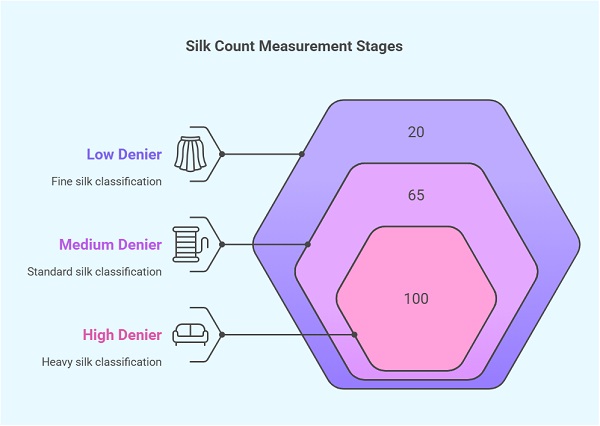Silk Count (Denier for Filament Silk)
The Formula for Silk Count (Denier for Filament Silk) Calculator
Denier = (Weight in grams × 9000) ÷ Length in meters
Where:
- Denier = The fineness of the filament silk
- Weight (grams) = The weight of the silk filament
- Length (meters) = The total length of the filament silk in meters
Table of Contents
What Is Silk Count?
Calculating silk count in denier ensures precise textile applications by standardizing filament silk measurements. Silk count refers to the weight of a specific length of silk yarn. It helps in determining yarn thickness, ensuring consistency in textile production. Traditional silk count systems vary, but they all measure the relationship between length and weight.
Common Silk Count Systems
- Denier: Measures filament silk thickness in grams per 9,000 meters.
- Tex: Measures fiber mass in grams per 1,000 meters.
- Mommes (mm): A weight-based unit primarily for silk fabrics.
- Grain per Yard: An older measurement used for raw silk.
What Is Denier?
Denier is the weight (in grams) of 9,000 meters of silk filament. It is commonly used in textiles to classify fiber fineness. Lower denier values indicate finer silk, while higher values represent thicker silk.

Denier Classification
- Low Denier (Fine Silk): 10D–30D (Light, delicate fabrics like chiffon)
- Medium Denier: 30D–100D (Common for silk garments)
- High Denier (Heavy Silk): 100D+ (Used in upholstery and durable textiles)
Why Convert Silk Count to Denier?
Denier is a unit of measurement that indicates the thickness or mass density of fibers. In the context of filament silk, denier quantifies the weight in grams of 9,000 meters of silk thread. A lower denier signifies finer silk fibers, while a higher denier indicates thicker fibers. This measurement is crucial for textile engineers when selecting silk for various applications, as it directly impacts the fabric's texture, strength, and appearance.
The Importance of Accurate Denier Calculation
Precise calculation of denier is vital for maintaining consistency in fabric production. It ensures that the silk used meets the required specifications for specific textile products. Accurate denier measurements affect the fabric's drape, durability, and overall quality, making it a critical parameter in textile engineering.
Converting silk count to denier is essential for:
- Standardization: Ensuring consistent yarn specifications.
- Quality Control: Maintaining the expected fabric characteristics.
- Blending Compatibility: Matching yarns for uniform texture and strength.
- Industry Compliance: Meeting global textile measurement standards.
Formula for Converting Silk Count to Denier

To convert silk count to denier, use the following formula:
Denier (D) = (Length in meters / Weight in grams) × 9,000
This formula determines how much 9,000 meters of the silk filament weighs in grams.
Step-by-Step Calculation Process:
- Sample Preparation: Obtain a representative sample of the silk filament. Ensure the sample is free from impurities and is conditioned to standard atmospheric conditions to avoid moisture affecting the weight.
- Measuring the Length: Accurately measure the length of the silk sample in meters. Precision in length measurement is crucial, as errors can significantly impact the denier calculation.
- Weighing the Sample: Use a calibrated analytical balance to determine the weight of the silk sample in grams. Ensure the balance is precise, as even minor discrepancies can lead to incorrect denier values.
- Applying the Formula: Insert the measured weight and length into the denier formula to calculate the denier of the silk filament.
This means the silk has a denier of 1,350D, making it suitable for medium-weight fabrics.
Using the Silk Count to Denier Calculator
Our calculator simplifies this conversion by:
- Accepting silk length (meters) and weight (grams) as inputs.
- Automatically calculating the denier.
- Providing instant results for textile professionals.
Applications in Textile Engineering
- Fabric Development: Choosing appropriate silk for specific textures.
- Product Quality Testing: Verifying silk yarn thickness.
- Manufacturing Efficiency: Ensuring uniformity in bulk silk production.
Conclusion
Converting silk count to denier is crucial in textile engineering for precision and quality. Using our Silk Count to Denier Calculator ensures efficiency, accuracy, and standard compliance in silk manufacturing.